Pool at the cottage itself
Build a pool is not very difficult, despite the fact that it is usually considered as an attribute of an expensive, respectable country house or villa. Before building a dacha pool, it is necessary to determine its design, type (ground and trench), location, depending on the conditions and size of the site. In the article we will discuss how to make an inexpensive pool in the country with your own hands, give step by step instructions and present photos and video materials.
Inflatable pool
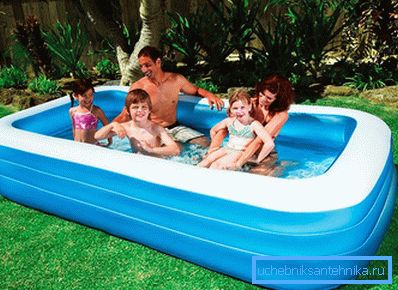
The simplest and most inexpensive type, made from PVC films of various densities, is an inflatable pool. It is a glued double frame, the space of which between the walls is filled with air under pressure. In large-sized pools, the walls do not have an air gap, since only a ring is inflated at the edges of the pool, which rises as the inner tank fills with water, preventing water from flowing out of the pool. In order not to constantly change the water, it is recommended to use a water filter. The sizes of the pools are small: they are within 5–6 m in diameter and up to 1.2 m in depth.
It is necessary to install the pool on a flat horizontal surface, even on a grassy lawn, but without sharp knots sticking out of the ground. Pumping the pool should be a special high-performance pumps, automobile compressor is not recommended.
Frame
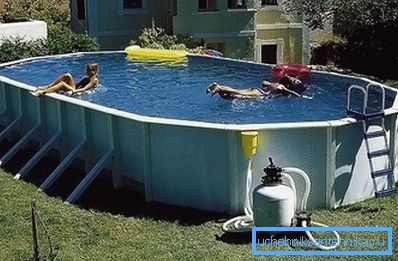
More complex design. Consists of a prefab durable frame, over which is put on the cover - liner of PVC film. The cover is filled with water, forming the specified geometry of the pool. As constructive are either solid rods or individual sections.

By configuration, pools can already vary considerably. The sizes of pools can be without restriction on length and width.
Concrete
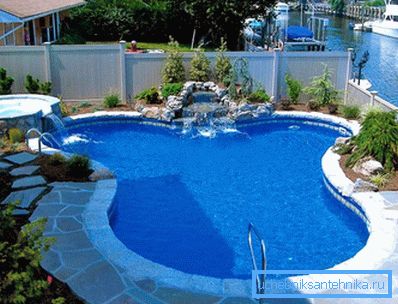
The construction of the capital basin requires a lot of labor, but they can be of any geometric shape, finish, various technological engineering solutions for filtering and filling (lowering), illumination, heating the pool.
For the construction of the pool can be used liner made of plastic, which is concreted in the ground. But this option limits your imagination and individuality.
Those who want to have a major swimming pool on the site should know how to build it in order to avoid trouble during subsequent operation. Any construction begins with the project, with determining the location of the basin, its area and configuration, the creation of engineering communications.
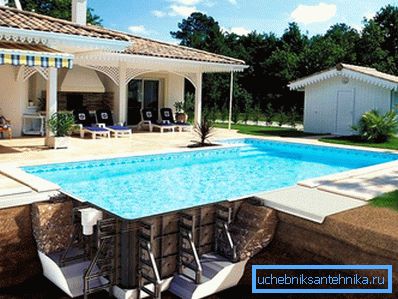
When choosing a place, it is necessary to take into account that there should be no trees near the pool, as the roots will reach for moisture, destroying concrete, and falling leaves falling into water will decompose and rot. The depth of the pool is not recommended to be greater than 1.5–2 m. After determining the location of the future object, its size and shape, it is marked on the surface of the land plot with a margin around the perimeter on each side for 1 m. This is necessary to install the formwork and prevent the soil from falling. .
For larger pool sizes, it is better to use the services of digging of excavation pits with special equipment. This will significantly reduce time and labor costs. The bottom of the excavation is leveled and filled with rubble and sand in layers of 20–30 cm.
If water circulation and filtration systems are provided, then engineering communications are laid according to the project.
Waterproofing is laid on the compacted sand. The budget option - 2 layers of roofing material. Concrete preparation 5–10 cm thick is poured over the waterproofing, reinforced with a mesh with a diameter of 4–5 mm and a cell spacing of 200 × 200 mm. The area of concrete preparation should be greater than the area of the pool, taking into account the thickness of the walls.
If the pool is heated, then 2 layers of waterproofing and extruded foam are laid on the concrete preparation.
For the formation of the bottom of the pools, formwork is installed around the perimeter, which must be securely fastened so that it does not lift or bend when filled with concrete.
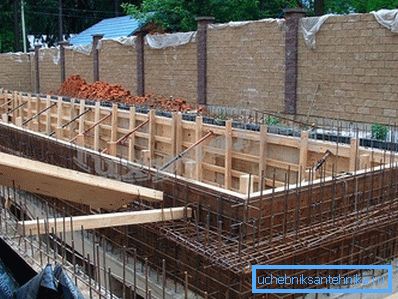
Rebar is laid on the insulation, with a diameter of 14–16 mm with two-layer reinforcement with a mesh of 200–250 mm. The armature is placed on special supports, so that between it and the waterproofing (insulation) was 3-5 cm. The bottom thickness should be 200–250 mm. Along the perimeter we install vertical bars of reinforcement for connection with the walls during their pouring. Having installed and connected the fittings, as well as connections for engineering systems (heating, lighting, circulation and filtration of water), the bottom is filled with concrete with vibration and leveling. Upon reaching the basic strength of concrete, 2 weeks after pouring, you can proceed to the construction of formwork for walls.
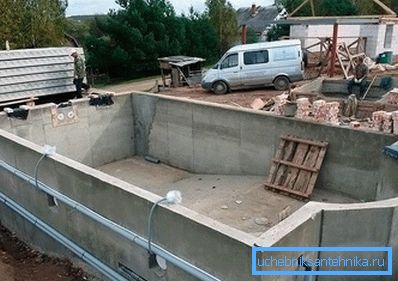
Wall formwork is made of prefabricated shields or plywood. Walls 200–250 mm thick must also be reinforced, for which reinforcement and reinforcing mesh are installed in the formwork. Do not forget to install elements for future engineering systems.

After pouring the walls with concrete and recruiting them basic strength, dismantling the formwork is carried out. The walls and the bottom of the pool are treated with cement milk or waterproofing mortar, and then proceed to facing the pool with mosaics or tiles.
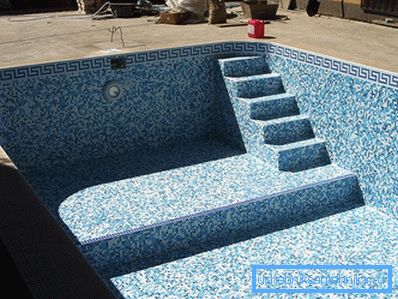
On the outer side of the pool wall is also insulated and filled with not heaving soil. Having connected all engineering communications, the pool is filled with water and check its functioning. After that, you can enjoy a holiday in the country with a pool.
Maybe you will be interested to read articles on the topic:
- How to insulate the external water supply?
- How to choose a filter for the pool?
- How to make drainage?
Video
We offer you a video on how to make a pool in the country: